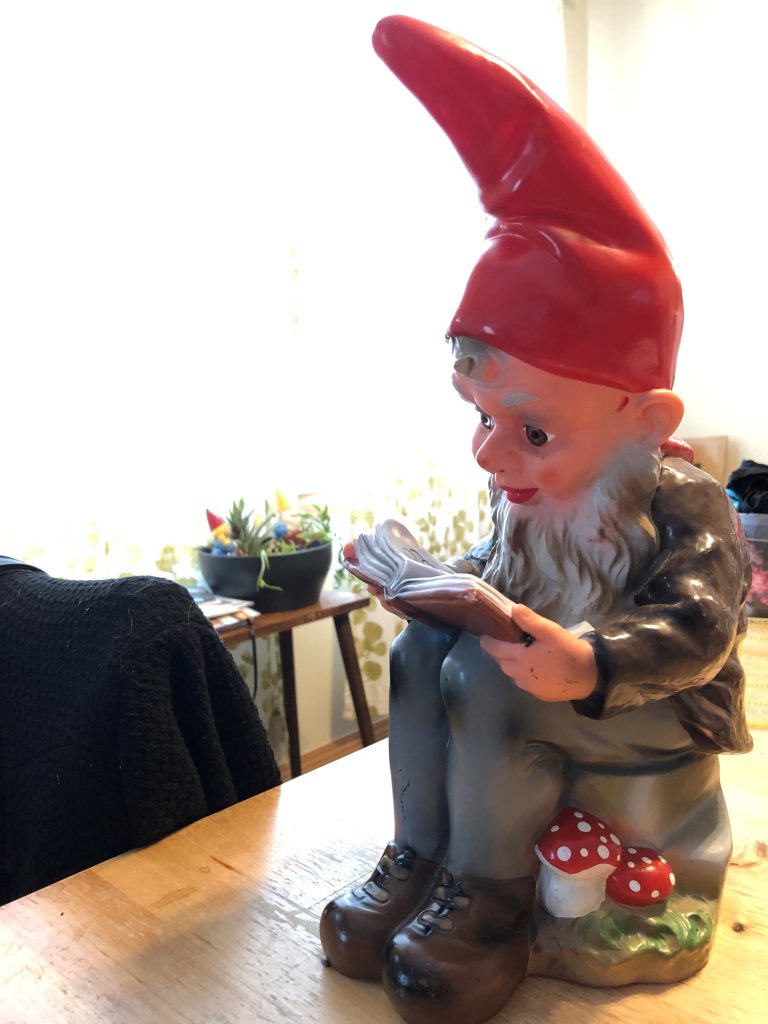January: a time to take stock, reflect on the past year and plan for the future. About time I paused to reflect on my personal highlights of 2019.
Continue reading “2019 Highlights”New Additions
A local antique mall had their first home and garden sale of the year today, and I came home with a couple additions.
Off to Vancouver
Jetting off to Vancouver for the annual meeting of the Association of Information Science & Technology (ASIS&T)! Stay posted for highlights.
In the mean time, you can have a look at the two panels I’ll be participating in, bringing the fan and the fun to information studies:
- The YouTube Formula: Information Work and Community-Building in a Visual Era
- Fandom, Food, and Folksonomies: The Methodological Realities of Studying Fun Life-Contexts
I will *probably* be dusting off the ol’ Twitter account for this, in case you would like to following along with what is bound to be a frenetic week (I’m not sure if I’m being sarcastic yet…)
Farmers or Poachers? Info Behaviour in a Postdigital Age
Henry Jenkins is often quoted for this line (or some variation of it) in a 2003 article in MIT Technology Review, entitled “Transmedia Storytelling”:
The kids who have grown up consuming and enjoying Pokemon across media are going to expect this same kind of experience from The West Wing as they get older. By design, Pokemon unfolds across games, television programs, films, and books, with no media privileged over any other. For our generation, the hour-long, ensemble-based, serialized drama was the pinnacle of sophisticated storytelling, but for the next generation, it is going to seem, well, like less than child’s play. Younger consumers have become information hunters and gatherers, taking pleasure in tracking down character backgrounds and plot points and making connections between different texts within the same franchise. And in addition, all evidence suggests that computers don’t cancel out other media; instead, computer owners consume on average significantly more television, movies, CDs, and related media than the general population.
 The analogy of fans as information hunter/gatherers is one that Jenkins has been making since Textual Poachers (1992). As an information scientist, I can’t help but think about how the analogy applies not just to the participatory practices and engagement of fans, but to all people, young and old, navigating an increasingly networked world.
The analogy of fans as information hunter/gatherers is one that Jenkins has been making since Textual Poachers (1992). As an information scientist, I can’t help but think about how the analogy applies not just to the participatory practices and engagement of fans, but to all people, young and old, navigating an increasingly networked world.
The kids Jenkins was talking about in 2003 are kids no longer; many have teenage kids of their own that have never known a world without the internet, social media and network technologies. The information landscape has evolved in ways that only further the integration and convergence of media. Speaking as representative of the generation in question, in the early ’00s we expected narrative extensions thanks to the carefully designed and marketed story worlds of our youth like Pokemon, Star Wars and Star Trek. The network integration of our life experiences promised by the internet was still mostly speculative then, and seeking out extensions required some labour. Our mediated forays as textual poachers were consciously undertaken. Engagement with both the narrative extensions we craved and the communities and technologies that hosted them was not achieved without some planning or forethought. Today, we expect those extensions to be seamlessly integrated in our digitally mediated experience of the world. Encounters with new extensions and opportunities to participate in the culture of fandom happen as a matter of course. The challenge is no longer accessing transmedia extensions, but parsing the perpetually auto-generating volume of content that exists around any given property.
Are we still hunter/gatherers, or have our information behaviours also evolved? To extend the analogy, have we perhaps developed from nomads, seeking out information in an environment of scarcity, into sedentary farmers cultivating vast fields of information, learning how to separate the wheat from the chaff?
A Fascination with Gnomes (Part 5)

Synthetic materials, like bakelite, made the manufacturing of objects much easier in the early 20th century. Over time, the use of plastics in manufacturing became essential to turning out consumer goods in mass quantities. The mass production of garden ornaments, particularly in America, took off in the post-war years. This was the era of pop-art and, for a few glorious years, kitsch was King. Continue reading “A Fascination with Gnomes (Part 5)”
A Fascination with Gnomes (part 4)
“Disneyfication” is a term we’re all too familiar with in the 21st century. After all, Disney is to entertainment what Google is to the Internet. Both are inescapable in modern daily life. Therefore, it’s not surprising that gnomes also have a Disney connection. What is surprising is how far back the connection goes and its importance in both the future success of Disney and of garden gnomes. The story of the garden gnome might in fact be a historical instance of transmedia branding.
Snow White and the Seven Dwarfs was the first Continue reading “A Fascination with Gnomes (part 4)”
Blood Orange Barleywine
First of all, it was never meant to be a barley wine. It just sort of happened. Here’s the story.
I wanted to try brewing with fruit. Lately the local supermarket had been stocking blood oranges and Bri and I had been taking full advantage. And the thought occurred to me, why not try my hand at a blood orange ale?
Farmhouse Edward Ale
To reproduce this recipe, I suggest following the guidelines provided by Joseph Lavoie of Beercraftr.
I wanted to try an american pale ale. This recipe is based on Beercraftr’s 1-gallon version of Hill Farmstead’s Edward Ale. This beer should be floral and herbal, with a distinctively clean, citrus taste. My own adjustments aimed to experiment with hop substitutions that would still achieve the citrus and pine of the original recipe.
A Fascination with Gnomes (Part 3)
 In 1872, two years before Griebel founded his company, August Heissner began his own decorative ceramics business. Both were located in Gräfenroda, Thuringia. Within a few years, both men were competing fiercely to dominate in the garden gnome industry. The question of which is most responsible for the Gartenzwerge is still highly contested. Heissner’s designs, ultimately, have come to be considered the most well-known and reproduced designs worldwide. At the time, however, Griebel and Heissner were not alone; by the early 20th century, there were at least 16 manufacturers of garden gnomes in east Germany, and more in surrounding regions.
In 1872, two years before Griebel founded his company, August Heissner began his own decorative ceramics business. Both were located in Gräfenroda, Thuringia. Within a few years, both men were competing fiercely to dominate in the garden gnome industry. The question of which is most responsible for the Gartenzwerge is still highly contested. Heissner’s designs, ultimately, have come to be considered the most well-known and reproduced designs worldwide. At the time, however, Griebel and Heissner were not alone; by the early 20th century, there were at least 16 manufacturers of garden gnomes in east Germany, and more in surrounding regions.
A Fascination with Gnomes (Part 2)
My gnome research started as idle noodling, but soon I’d fallen deep down the rabbit hole. Once I’d scratched the brightly-painted surface of my subject, each succeeding layer of historical record brought me some new insight. It’s been weeks now, during which I’ve uncovered a wealth of interesting facts and implications, and there’s still no end in sight…
Continuing where I left off: the medieval origins of the modern-day garden gnome.


